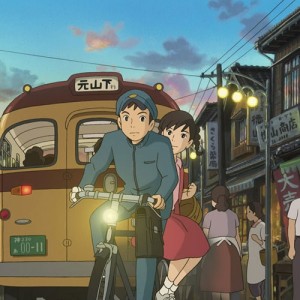The Summer’s Best-Kept Secret: From Up on Poppy Hill
Looking back over the movies of summer 2013, it’s been a lackluster season for Hollywood so far — and that applies particularly to one of my favorite movie categories, animation. The best of the summer was Pixar’s latest sequel, Monsters University — a fine little film, although weaker than any non-Cars Pixar film since A Bug’s Life. It was all downhill from there (with the caveat that at this writing I haven’t seen Cloudy with a Chance of Meatballs 2).

There was, however, a more ambitious and artful animated film in theaters this summer, even though it didn’t play widely and wasn’t heavily advertised. From Up on Poppy Hill (on home video September 3) is the latest from Studio Ghibli, the Japanese animation house behind The Secret World of Arrietty and Ponyo.
Co-written by Ghibli co-founder Hayao Miyzaki and directed by his son Goro Miyazaki (Tales From Earthsea), From Up on Poppy Hill is a gently naturalistic departure from the high-flying fantasy for which the studio is best known… Set in the Japanese coastal city of Yokohama in 1963, the year before the Tokyo Olympics, Poppy Hill is at once a sentimental coming-of-age tale, a nostalgic period piece rich in cultural specificity, and an exploration of the relationship between the past, present, and future.
The meandering story follows a schoolgirl named Umi (voiced in the English dub by Sarah Bolger), a typically responsible young Miyazakian heroine who, in her mother’s absence, helps pull her weight at her grandmother’s boarding house by preparing meals for her siblings and boarders. Umi’s morning routine includes raising a pair of signal flags over the harbor — a ritual that, also typical for Ghibli, the film is in no rush to explain.
At school, a fraternity of academic boys’ clubs engages in activism to try to save an elegant but dilapidated old building called the “Latin Quarter,” which serves as a picturesque home base for the clubs. One of these boys, a strong-willed fellow named Shun (Anton Yelchin), pulls a publicity-seeking daredevil stunt that makes very different impressions on Umi and her younger sister.
Then the story takes a romantic turn that is all the more intriguing for the characters being, in the words of the elder Miyazaki, “pure and straight as an arrow,” unwilling to compromise their “admiration and respect for the opposite sex.” When complications arise, the protagonists confront them head-on; the younger Miyazaki gives his characters none of the awkwardness with the opposite sex that his father sometimes has (My Neighbor Totoro, Kiki’s Delivery Service).
Respect and thoughtfulness, initiative and integrity are key moral themes. The legacy of World War II and the Korean War weigh on the present as the characters contemplate how to honor the past (symbolized by the Latin Quarter) while looking to the future (the coming Olympics).
Beautifully naturalistic art is a key strength in a Ghibli film, and Poppy Hill is no exception. The town, with its mossy, stone-walled terraces, tile-roofed wooden houses and bustling waterfront, joins other unforgettable Ghibli locations: the bathhouse in Spirited Away, Laputa in Castle in the Sky and Toyko in Whisper of the Heart (which Poppy Hill resembles in a number of ways). A sprightly jazz-inflected score is among the movie’s key strengths.
In sharing with you my appreciation for From Up on Poppy Hill, I almost feel as if I’m sharing a secret. Not only have most Americans not seen or even heard of it, they haven’t ever seen anything like it. It’s not a film for young children, or for anyone who needs fast-paced gags or explosions. For receptive viewers, though, including thoughtful tweens, it’s a rewarding film to be savored with gratitude.
Related
From Up on Poppy Hill [video]
Studio Ghibli takes a break from high-flying fantasy in this naturalistic, nostalgic coming-of-age story.
Recent
- Benoit Blanc goes to church: Mysteries and faith in Wake Up Dead Man
- Are there too many Jesus movies?
- Antidote to the digital revolution: Carlo Acutis: Roadmap to Reality
- “Not I, But God”: Interview with Carlo Acutis: Roadmap to Reality director Tim Moriarty
- Gunn’s Superman is silly and sincere, and that’s good. It could be smarter.
Home Video
Copyright © 2000– Steven D. Greydanus. All rights reserved.